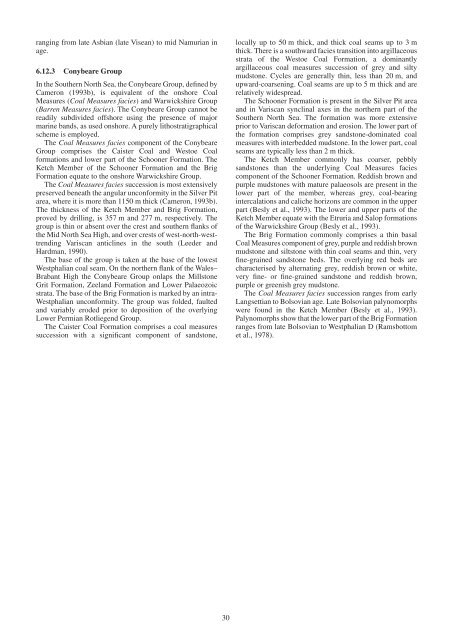Lithostratigraphical framework for Carboniferous successions of ...
Lithostratigraphical framework for Carboniferous successions of ...
Lithostratigraphical framework for Carboniferous successions of ...
You also want an ePaper? Increase the reach of your titles
YUMPU automatically turns print PDFs into web optimized ePapers that Google loves.
anging from late asbian (late visean) to mid Namurian in<br />
age.<br />
6.12.3 Conybeare Group<br />
in the southern North sea, the Conybeare Group, defined by<br />
Cameron (1993b), is equivalent <strong>of</strong> the onshore Coal<br />
measures (Coal Measures facies) and warwickshire Group<br />
(Barren Measures facies). The Conybeare Group cannot be<br />
readily subdivided <strong>of</strong>fshore using the presence <strong>of</strong> major<br />
marine bands, as used onshore. a purely lithostratigraphical<br />
scheme is employed.<br />
The Coal Measures facies component <strong>of</strong> the Conybeare<br />
Group comprises the Caister Coal and westoe Coal<br />
<strong>for</strong>mations and lower part <strong>of</strong> the schooner Formation. The<br />
Ketch member <strong>of</strong> the schooner Formation and the Brig<br />
Formation equate to the onshore warwickshire Group.<br />
The Coal Measures facies succession is most extensively<br />
preserved beneath the angular uncon<strong>for</strong>mity in the silver pit<br />
area, where it is more than 1150 m thick (Cameron, 1993b).<br />
The thickness <strong>of</strong> the Ketch member and Brig Formation,<br />
proved by drilling, is 357 m and 277 m, respectively. The<br />
group is thin or absent over the crest and southern flanks <strong>of</strong><br />
the mid North sea High, and over crests <strong>of</strong> west-north-west-<br />
trending variscan anticlines in the south (Leeder and<br />
Hardman, 1990).<br />
The base <strong>of</strong> the group is taken at the base <strong>of</strong> the lowest<br />
westphalian coal seam. On the northern flank <strong>of</strong> the wales–<br />
Brabant High the Conybeare Group onlaps the millstone<br />
Grit Formation, Zeeland Formation and Lower palaeozoic<br />
strata. The base <strong>of</strong> the Brig Formation is marked by an intrawestphalian<br />
uncon<strong>for</strong>mity. The group was folded, faulted<br />
and variably eroded prior to deposition <strong>of</strong> the overlying<br />
Lower permian Rotliegend Group.<br />
The Caister Coal Formation comprises a coal measures<br />
succession with a significant component <strong>of</strong> sandstone,<br />
30<br />
locally up to 50 m thick, and thick coal seams up to 3 m<br />
thick. There is a southward facies transition into argillaceous<br />
strata <strong>of</strong> the westoe Coal Formation, a dominantly<br />
argillaceous coal measures succession <strong>of</strong> grey and silty<br />
mudstone. Cycles are generally thin, less than 20 m, and<br />
upward-coarsening. Coal seams are up to 5 m thick and are<br />
relatively widespread.<br />
The schooner Formation is present in the silver pit area<br />
and in variscan synclinal axes in the northern part <strong>of</strong> the<br />
southern North sea. The <strong>for</strong>mation was more extensive<br />
prior to variscan de<strong>for</strong>mation and erosion. The lower part <strong>of</strong><br />
the <strong>for</strong>mation comprises grey sandstone-dominated coal<br />
measures with interbedded mudstone. in the lower part, coal<br />
seams are typically less than 2 m thick.<br />
The Ketch member commonly has coarser, pebbly<br />
sandstones than the underlying Coal measures facies<br />
component <strong>of</strong> the schooner Formation. Reddish brown and<br />
purple mudstones with mature palaeosols are present in the<br />
lower part <strong>of</strong> the member, whereas grey, coal-bearing<br />
intercalations and caliche horizons are common in the upper<br />
part (Besly et al., 1993). The lower and upper parts <strong>of</strong> the<br />
Ketch member equate with the etruria and salop <strong>for</strong>mations<br />
<strong>of</strong> the warwickshire Group (Besly et al., 1993).<br />
The Brig Formation commonly comprises a thin basal<br />
Coal measures component <strong>of</strong> grey, purple and reddish brown<br />
mudstone and siltstone with thin coal seams and thin, very<br />
fine-grained sandstone beds. The overlying red beds are<br />
characterised by alternating grey, reddish brown or white,<br />
very fine- or fine-grained sandstone and reddish brown,<br />
purple or greenish grey mudstone.<br />
The Coal Measures facies succession ranges from early<br />
Langsettian to Bolsovian age. Late Bolsovian palynomorphs<br />
were found in the Ketch member (Besly et al., 1993).<br />
palynomorphs show that the lower part <strong>of</strong> the Brig Formation<br />
ranges from late Bolsovian to westphalian d (Ramsbottom<br />
et al., 1978).

















